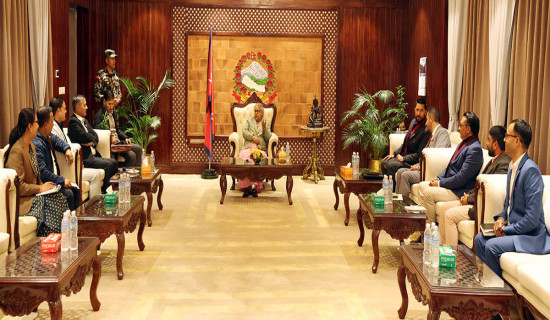- Monday, 22 December 2025
Can Surgical Mask Save Us From Pollution?
With the rising pollution in the Kathmandu Valley, the world Air Quality Index (AQI) ranking reveals that Kathmandu has been listed at the top for unhealthy air. The Ministry of Health and Population urges the public to wear masks due to rising air pollution, but the question is, are surgical masks effective against pollution? The Ministry has issued a strong advisory in the middle of rising air pollution levels in Kathmandu, urging citizens to wear masks and avoid unnecessary outdoor activities, particularly in highly polluted areas. Dr. Prakash Budhathoki, the Ministry's spokesperson, emphasised the severe health risks associated with air pollution, which include cardiovascular problems, respiratory issues, and increased risk of diseases like asthma and cancer.
Vulnerable groups such as children, pregnant women, and the elderly are particularly at risk, with air pollution contributing significantly to annual mortality rates in Nepal. The precautions advised by the Minister, including wearing masks, primarily involve the use of the most common surgical masks, which are designed to protect patients from respiratory droplets expelled by healthcare providers during medical procedures. While these masks offer some protection against large airborne particles such as pollen and dust, they are not specifically engineered to filter out fine grainy matter commonly present in pollution.
Particulate Matter
The air in Kathmandu is getting worse because of several things happening simultaneously. Rapid urbanisation, industrial expansion, and increasing vehicles have significantly increased pollution. Old motor vehicles, poor-quality road infrastructure, wood-burning practices, and brick kilns that are all contributing to high levels of Particulate Matter (PM10) and (PM2.5), as well as gaseous pollutants such as ozone, nitrogen dioxide, and volatile organic compounds like benzene and carbon monoxide, and sulfur dioxide.
Additionally, the roads from Maharajgunj to Kalanki, Banepa to Dhulikhel, and Satdobato to Ekantakuna are causing dust and pollution, equivalent to a factory production line. Geographical features and weather patterns also play a role in intensifying the effects of pollution. Kathmandu Valley, nestled amidst mountains measuring from 2000 to 2800 metres in height, creates a natural bowl that encloses the urban areas. This unique topography, coupled with weather conditions, contributes to the persistence of poor air quality in Kathmandu. While the valley's hills and mountains act as natural obstacles, and slow down the spread of pollutants, it's crucial to recognise that geography alone isn't solely accountable for the issue.
The frequency of wildfires in various parts of the country has seen a rise. As per the Department of Forests and Soil Conservation's records, currently, wildfires are occurring at 92 different locations. Also, Sundar Sharma, an expert on wildfires and Under Secretary at the Department, states that the increase in forest fires has contributed to the decline of air quality in major towns such as Kathmandu and Pokhara. The smoke from these wildfires poses serious health risks. The air quality has significantly worsened, with Kathmandu ranking as the most polluted city globally, registering an AQI of 165.
The combination of ongoing forest fires, vehicle, and industrial emissions, and the burning of agricultural residue across Nepal has resulted in toxic air. In a recent statement to the press, Ministry spokesperson Budhathoki pointed out how air pollution harms our bodies— affects many parts, like the heart, lung, brain, eyes, nose, ears, and throat— that raises the chances of getting asthma, especially, in young children and cancer in youth. Research indicates that the polluted air is significantly shortening the lifespan of Nepali individuals.
Some pollutants measured by the AQI, such as Ozone and Sulphur dioxide, are not easily removed. However, PM 2.5 and PM 10 can be significantly reduced when it rains for a prolonged period. (PM 2.5 and PM 10 are small particles in the air, from sources like vehicles and dust that can harm health when inhaled). As rain falls, it collects small particles called aerosols. This gathering process, called coagulation, helps remove pollutants like sulfates and organic particles from the air. Therefore, extended rainfall can contribute to a partial reduction in air pollution, primarily targeting the Particulate Matter, which is just one category of pollutants present in our atmosphere.
Better protection
The concerned authorities must take steps to tackle pollution across the country. Effective efforts should made to manage them better by creating firebreaks and improving firefighting capabilities to contain the forest fires. Dust from under-construction roads is another factor to be addressed through paving and regular maintenance. Brick factories’ tighter regulations to reduce emissions and vehicle standards should be enforced more strictly to cut down on pollution. One must limit outdoor time during high AQI days, and decrease the intensity of outdoor activities, as longer outdoor exposure and more fatiguing activities raise the risk of health issues from air pollution.
Consider wearing a mask. However, not all masks offer the same protection against particle pollution. Cloth or dust masks aren't effective at filtering out fine particles. For better protection, especially against fine particulate matter like PM2.5, it's recommended to use specialised masks such as N95 respirators or equivalents. These masks are designed to filter out very small particles— used in areas with high pollution levels.
(Karki is a Kathmandu-based writer.)











-(1)-original-thumb.jpg)




